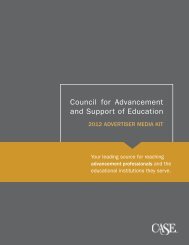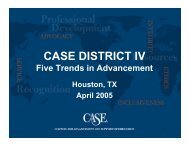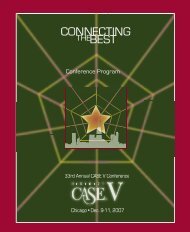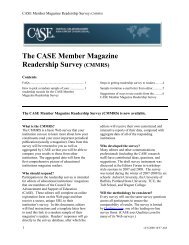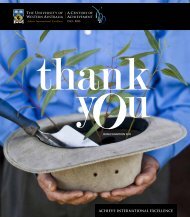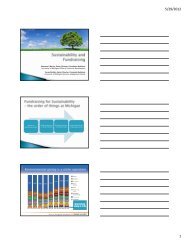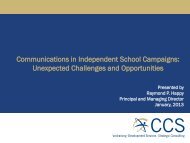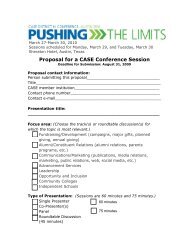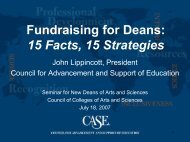You also want an ePaper? Increase the reach of your titles
YUMPU automatically turns print PDFs into web optimized ePapers that Google loves.
Administrators not seen in<br />
great numbers by previous<br />
generations include those<br />
working in information<br />
technology, health and career<br />
counseling, writing resources,<br />
{and other student services.<br />
Auxiliary<br />
14.4 percent<br />
Plant<br />
operation<br />
6.7 percent<br />
Instructional<br />
23 percent<br />
Student services<br />
12.8 percent<br />
Academic<br />
support<br />
5 percent<br />
<strong>Kenyon</strong> expenses<br />
by function, 2010-11:<br />
$102,916,000<br />
Financial aid<br />
21.5 percent<br />
Reserves<br />
5.3 percent<br />
Institutional<br />
9 percent<br />
Information services<br />
2.3 percent<br />
was supposed to start. It was kind of like just throwing you out of<br />
the Gates of Hell into the real world.”<br />
Her father, Steven R. Hayes, is a corporate lawyer who knows<br />
his way around higher education; he has a son in college and his<br />
father is a former president of Marshall University. “I’m very<br />
fond of <strong>Kenyon</strong>,” he said. “I really like what they do. My daughter<br />
loved it.”<br />
Like his daughter, he wonders why <strong>Kenyon</strong> does not provide<br />
more help in finding internships and developing career choices.<br />
“One would have expected, given the price of <strong>Kenyon</strong>, strong, active<br />
support,” he said. He also thinks the <strong>College</strong> should do more to<br />
help club sports, such as providing the women’s rugby team with a<br />
trainer. Women’s rugby is one of fourteen club sports at the <strong>College</strong>.<br />
The services advocated by Jo Hayes and her father are typical of<br />
those expected by many of today’s college consumers.<br />
<strong>Kenyon</strong> does have a Career Development Office, with a staff of<br />
five. The number of full-time employees at <strong>Kenyon</strong> has grown to<br />
574, from 455 in 2000. The roll call in that time includes, among<br />
others, new staff for multicultural affairs, student activities, and<br />
financial-aid assistance; a women’s lacrosse coach; a crew of about<br />
nine to run the KAC; and about nine new professors added during<br />
the period 2001-03 as the annual teaching load was reduced to five<br />
courses a year, from six. And the curriculum continues to grow,<br />
adding, for example, courses in Arabic, environmental studies, and<br />
neuroscience. A film major was added as well.<br />
“There’s always new knowledge, and the consumer is going to<br />
demand access to new knowledge,” said Joseph G. Nelson, <strong>Kenyon</strong><br />
vice president for finance. Nelson likes to add that knowledge<br />
multiplies—there is always more to learn. He’s seen the budget<br />
grow about tenfold since he arrived at <strong>Kenyon</strong> in 1978. “The<br />
<strong>College</strong>’s entrance qualifications are dramatically different than<br />
they were then. That’s because the <strong>College</strong> has something to offer to<br />
that sector of the market. The <strong>College</strong> wants to improve the quality<br />
to attract a higher level of consumer.”<br />
The faculty course load was reduced before Nugent arrived—<br />
“and, indeed, it does add costs,” she said. One reason for the switch<br />
was to enhance research opportunities that are attractive to faculty.<br />
Nugent believes teaching should be the highest priority at a liberal<br />
arts college and that the shift has enabled more time for course<br />
preparation, advising, and grading.<br />
“One reason why some parents are willing to spend $50,000 is<br />
they want excellent teaching,” she said.<br />
What You Get<br />
Excellent teaching at <strong>Kenyon</strong> is defined partly by the ten-to-one<br />
student-faculty ratio and ready access to top-notch professors.<br />
Provost Nayef Samhat believes the “intimate learning environment”<br />
pays off in a strong academic community. In “the pursuit<br />
of research and scholarship,” moreover, faculty members deepen<br />
their knowledge, expand their contacts with colleagues worldwide,<br />
and familiarize themselves with new tools, trends, and methodologies—all<br />
of which translate into more challenging classes and more<br />
opportunities for students.



